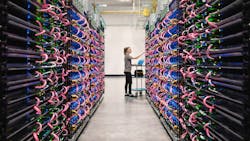Innovium Closes Massive Funding Round to Put Out Switch Chips
Cash continues to flow into companies challenging Broadcom in the market for Ethernet switch chips. The latest funding belongs to Innovium, which raised $77 million in additional capital on Wednesday to produce chips that can handle the growing flood of information inside data centers.
Innovium said that the funds would help drive customer production ramps of its new Teralynx switch chips. Last month, the company started sampling 12.8 terabit-per-second silicon that supports up to 400 gigabit Ethernet, which is the latest standard. That puts it in competition with Broadcom’s third generation Tomahawk chip, which also strings together 128 100 Gb/s ports to provide bandwidth of 12.8 Tb/s.
“Data center networks are experiencing dramatic traffic growth and face new requirements, driven by public and hybrid cloud, machine learning, analytics, storage and video,” said Asheem Chandna, a partner at Greylock Partners, a venture capital firm that joined Qualcomm Ventures, Walden International and Capricorn Investments, among others, to invest in Innovium.
Innovium, founded by three former engineering executives from Broadcom, has pulled in $165.3 million over the last three years to muscle into the market for high performance – and expensive – switch chips. Currently, Broadcom holds 96 percent market share in 10 gigabit and faster Ethernet chips, said Bob Wheeler, principle networking analyst for The Linley Group. The new funding could help convince customers looking for another vendor that Innovium can deliver production volumes.
The dogfight over the remaining four percent includes Hewlett Packard, Cisco Systems and Juniper Networks, all of which design custom chips for their switches. Other marginal players are Taiwan’s Nephos and Mellanox Technologies, which plans to sample a new 6.4 Tb/s chip that handles up to 400 gigabit Ethernet by the middle of 2018. Marvell is also trying to invade into Broadcom’s territory through its $6 billion acquisition of Cavium last year.
The competition has thickened as bandwidth requirements in hyperscale data centers operated by Google, Baidu, Amazon, Microsoft, Facebook, Alibaba and others grow. The amount of information flowing “north-south” in from the internet is always growing. But information moving “east-west” within data centers is growing even faster as more of what happens on the internet is processed and analyzed.
Broadcom has long overwhelmed rivals with the Tomahawk’s performance, but many companies are trying to set themselves apart by adding flexibility to these highly specialized chips. Barefoot Networks' Tofino switch can be programmed using software tools, allowing customers to key in additional features instead of installing new chips. Barefoot is another rising star in the networking space, having raised $155.4 million in venture capital.
Though not as programmable as Barefoot's Tofino or Cavium’s Xpliant switch chips, Innovium’s Teralynx products can also be customized to an extent. The San Jose, California-based company is betting on that little bit of programmability to gain an edge over the Tomahawk 3, which Broadcom began sampling a little over a year after releasing the industry standard Tomahawk 2.
“Barefoot and Cavium went for extreme programmability,” Wheeler told Electronic Design. “Innovium did a design that would deliver maximum density and power dissipation competitive with Broadcom, and if they made it programmable, they would not have been able to do that. They sort of compromised and added some programmability.”
Innovium may not have many chances to bite into Broadcom’s market share. In addition to the skyrocketing costs of developing and manufacturing chips, the pool of potential customers is relatively small. Last year, there were about 400 hyperscale data centers in the world, with an estimated 500 by 2020, according to market researcher Synergy Research Group.
These factors raise the stakes in an already high stakes market, which Wheeler estimated is worth more than a billion dollars. “If you win a Google or a Microsoft, you are going to win most of their business,” Wheeler told Electronic Design. “They have one design per generation of data center and replicate that one design [in multiple data centers].”
“Once you have won that generation of data center, you are going to ship very high volumes of product and that translates into significant market share,” Wheeler said, adding that internet giants such as Google and Amazon roll out new generations of servers roughly every two years. “That makes this market very high risk, because you either win or you don’t.”
About the Author
James Morra
Senior Editor
James Morra is the senior editor for Electronic Design, covering the semiconductor industry and new technology trends, with a focus on power electronics and power management. He also reports on the business behind electrical engineering, including the electronics supply chain. He joined Electronic Design in 2015 and is based in Chicago, Illinois.

